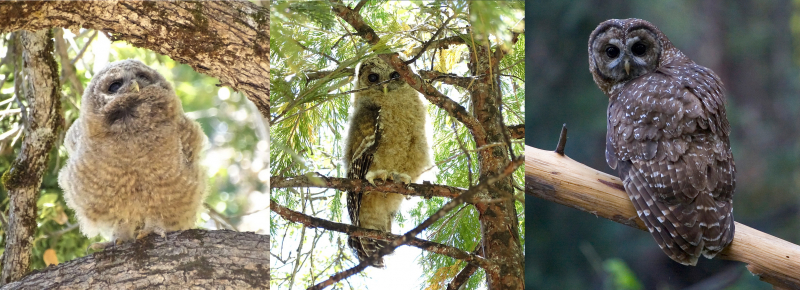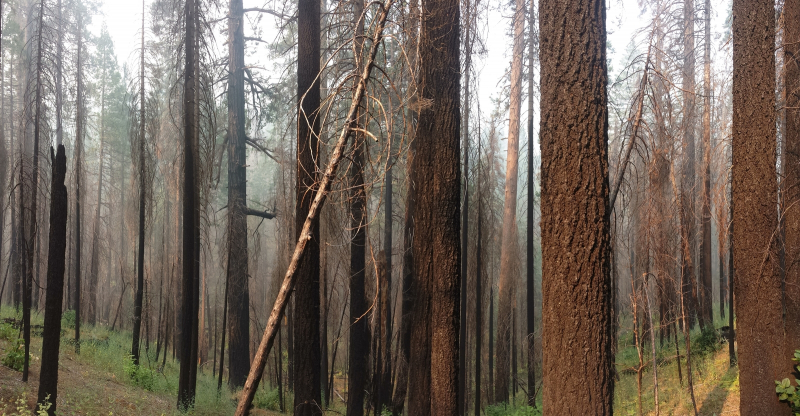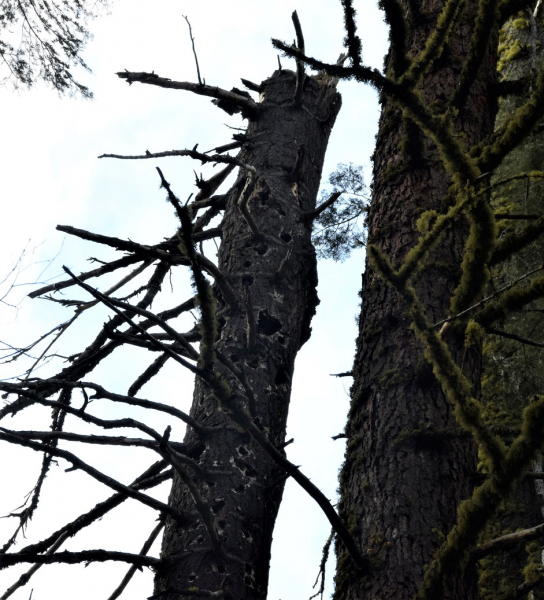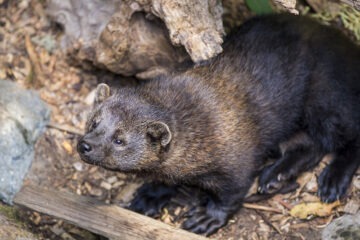For several years, our donors have been supporting research on California spotted owls, a species of “special concern” that finds a haven in Yosemite’s old-growth forest. Wildfires, including the massive 2013 Rim Fire, have painted swaths of that critical habitat with ash and charred wood — and have prompted researchers to wonder how spotted owls are adapting to their new landscape.
In May, with snow still spread out in soft quilt under the trees, our project coordinator headed into the woods with a park crew to search for signs of the rare birds. Their goal: locate and document spotted owls and their nests at historically occupied sites in burned and unburned parts of the park. The observations will help improve scientific understanding of how fire affects the owls and their ability to nest and reproduce.
What goes into an owl survey? A lot of quiet wandering, watching and listening. Here’s a glimpse:
As they walk the woods, the crews are searching for signs of owl occupancy, such as nest sites, feathers and pellets — and, of course, the birds themselves, flying or roosting overhead. Whenever possible, they collect demographic information, including the species, sex and age of the birds they observe.
While songbird researchers can capture and closely examine the juncos, tanagers, grosbeaks and other species that wing their way through Yosemite’s meadows, owl surveyors rely on binoculars (or zoom lenses) and keen ears to study their subjects from a distance. They use clues such as sound, size and plumage to figure out an owl’s age, sex and species.
SOUND
Calls can help indicate whether an owl is male or female. Spotted owls can create more than a dozen different sounds, including whistled “contact calls” to mates; raspy, agitated calls and barks; soft, sweet “nest calls”; and “begging calls” made by hungry youngsters. Many of the spotted owl’s calls are similar to those made by other species, so are difficult to use for identification.
The exception: three-note (hoo, hoo-hoo) and four-note (hoo, hoo-hoo, hooo) location calls, used to mark territory, which are both unique to the spotted owl and its most common sound. Male owls typically have lower voices than females — though not always! (Want to hear a California spotted owl? The Cornell Lab of Ornithology’s Macaulay Library has a number of recordings, including this one from Sierra County.)
SIZE
Though a less reliable indicator than sound, size can help scientists decide a bird’s sex. Adults are typically 18-19 inches long, with a 40-inch wingspan. On average, females are about 10 percent heavier than males. If a pair isn’t sitting side by side, however, it can be difficult to tell which bird is bigger. Spotted owls are slightly smaller than barred owls, and quite a bit smaller than great grays, but are one of the largest owl species in the park. Here’s a cheat sheet on Yosemite’s owls:
| SPECIES | LENGTH * | WINGSPAN * | STATUS |
|---|---|---|---|
| Great gray owl | 24-33.1″ | 53.9-60.2″ | Rare, Calif. Endangered Species |
| Great horned owl | 18.1–24.8″ | 39.8–57.1″ | Common |
| Barred owl | 16.9–19.7″ | 39–43.3″ | Invasive, first seen in Yosemite in 2016 |
| California spotted owl | 18.5–18.9″ | 39.8″ | Uncommon, Calif. Species of Special Concern |
| Long-eared owl | 13.8–15.7″ | 35.4–39.4″ | Rare, Calif. Species of Special Concern |
| Short-eared owl | 13.4-16.9″ | 33.5-40.6″ | Rare |
| Barn owl | 12.6–15.7″ | 39.4–49.2″ | Occasional |
| Burrowing owl | 7.5–9.8″ | 21.7″ | Occasional |
| Western screech owl | 7.5–9.8″ | 21.7–24.4″ | Common |
| Northern saw-whet owl | 7.1–8.3″ | 16.5–18.9″ | Rare |
| Northern pygmy owl | 6.3–7.1″ | 15″ | Uncommon |
| Flammulated owl | 5.9–6.7″ | 16.1″ | Uncommon |
* Stats from AllAboutBirds.org, a Cornell Lab of Ornithology site
FEATHERS AND FACES
Plumage is a key tool for determining a bird’s age. Juvenile spotted owls, under 1 year old, look like small (and alarmingly cute) fluffy pom-poms with beaks and eyes. Their tail feathers (or retrices, scientifically speaking) have a bright white, pointed tip and, usually, a tuft of down.
As the owls age into the subadult range (1-2 years old), their tail tips start to wear down. Younger subadults still have a sharp, bright white point on their retrices, while older ones have rounded white tips.
Once they’ve made it through their second year of life, the owls molt their original tail feathers and grow adult ones: rounded, with no tuft or point, and mottled with brown.


 Searching for and identifying owls requires solid listening (and hooting) skills, and a lot of patience. One owl crew member described the payoff in a tale from a spring expedition: After hooting into darkness for more than an hour, she heard a four-note location call in the distance. Eventually, a male spotted owl arrived. A muffled whistle wafted down from high overhead — a female, in a nest cavity. This was the third year in a row that owls had been observed using the same tree, in an unburned patch at the edge of the Rim Fire footprint.
Searching for and identifying owls requires solid listening (and hooting) skills, and a lot of patience. One owl crew member described the payoff in a tale from a spring expedition: After hooting into darkness for more than an hour, she heard a four-note location call in the distance. Eventually, a male spotted owl arrived. A muffled whistle wafted down from high overhead — a female, in a nest cavity. This was the third year in a row that owls had been observed using the same tree, in an unburned patch at the edge of the Rim Fire footprint.
As of the end of early July, Yosemite’s owl crew had located 16 spotted owl nests, including several within the perimeter of the Rim Fire, and had detected 17 juveniles.
This year, the owl team isn’t just looking up into the trees. They’re also studying the owls’ habitat from above using LiDAR, a digital imaging technique. By combining LiDAR data with information from ground surveys, scientists can create a clear picture of the conditions around spotted owl nest and roosting sites. What kinds of trees are they choosing? What does the surrounding canopy look like?
As scientists continue to study whether and how spotted owls adapt in the wake of fires, another question looms: How will the species fare when faced with competition from their larger, more aggressive lookalike? The barred owl (Strix varia), an invasive species that shares a genus with spotted owls, was first reported in Yosemite last year; crews reported another sighting within a spotted owl territory this spring. Compared with spotted owls, barred owls are larger and more aggressive, eat a greater variety of prey, and produce more offspring. Over the past century, the barred owl’s range has expanded westward from the eastern U.S., reaching the Pacific Northwest and California.
By taking the time to study spotted owls, crews are collecting valuable data to inform efforts to manage Yosemite’s wildlife, habitats and wildfires. Supporting efforts to understand and protect a vulnerable species as it responds to a changing environment can help ensure that years from now, the telltale hoo, hoo-hoo, hooo will still echo through twilit forests, a melodic reminder of the resilient flyers that make their homes in the ancient trees.
Main image: A spotted owl perched on a charred trunk in the footprint of the 2013 Rim Fire. © NPS/Jade Ujcic-Ashcroft



